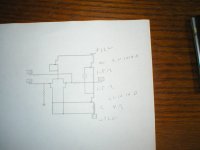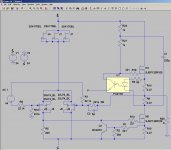J2 is 30 WPC into 8 ohm and 15 WPC into 4ohm.
This suggest that the bias current is about 1.4A.
Maximum output voltage needs to be at least 21.9v, so rail voltage should be higher, maybe around 23-24 volt considering the 18V transformer.
This suggest that the bias current is about 1.4A.
Maximum output voltage needs to be at least 21.9v, so rail voltage should be higher, maybe around 23-24 volt considering the 18V transformer.
hi guys,
need opinion,
recently i used Class A 1! mosfet solid state mono block 5watt build from www.audioprjects.com /Mark housten created. it was modified from zen class A Nelson Pass. the sound is so sweet, but difficuilt to drive my 2 way dayton bookshelf.
My qoustion is:
is there better modified to push-pull, or put another N-mosfet like zenNnelson pass ?
my travo(5A) secondary: 12 volt, third : 6 volt. can i medified s2'nd & 3'rd to make hybrid to drive 2c51 tube for being buffer ? what kind a schema should i build ?
welcome any suggestion !
thank's anyway !
need opinion,
recently i used Class A 1! mosfet solid state mono block 5watt build from www.audioprjects.com /Mark housten created. it was modified from zen class A Nelson Pass. the sound is so sweet, but difficuilt to drive my 2 way dayton bookshelf.
My qoustion is:
is there better modified to push-pull, or put another N-mosfet like zenNnelson pass ?
my travo(5A) secondary: 12 volt, third : 6 volt. can i medified s2'nd & 3'rd to make hybrid to drive 2c51 tube for being buffer ? what kind a schema should i build ?
welcome any suggestion !
thank's anyway !
Hi spiritm2r,
ZCA from Mark Houston is very good with fullrange (high sensitivity) speakers. I use them with my Audio Nirvana super10 in downsized Autograph replica, without any correcting circuit, and the sound is delicious, with ample, tuneful bas . You should try it with FRs, or try Pass' "DeLite" amp.
Good luck,
M.
ZCA from Mark Houston is very good with fullrange (high sensitivity) speakers. I use them with my Audio Nirvana super10 in downsized Autograph replica, without any correcting circuit, and the sound is delicious, with ample, tuneful bas . You should try it with FRs, or try Pass' "DeLite" amp.
Good luck,
M.
Not forgetting about the Source resistor question but, does this post raise some questions? Answer some???
http://www.diyaudio.com/forums/pass-labs/161716-aleph-current-source-mod.html

http://www.diyaudio.com/forums/pass-labs/161716-aleph-current-source-mod.html

Not forgetting about the Source resistor question but, does this post raise some questions? Answer some???
http://www.diyaudio.com/forums/pass-labs/161716-aleph-current-source-mod.html

just another way to skin a cat .......
I'm not saying that any other is better - but - you must count that that way you have max 2V window for Uce of small bjt .
is it enough - try ;
for moderate and medium levels certainly is , but trouble is around extremes .
you must count that that way you have max 2V window for Uce of small bjt
I do not understand why.😕
Or do you mean when using power Jfets only?
My intention is to mod an Aleph J, using regular Fets.
Last edited:
Yes, in an Aleph CS, the "govonor" transistor would have much less Vce due to the lower Vth of the Sic devices. The operation of this area of the circuit will degrade because of this. In a J2 however...
Looking at the simplified schematic of the J2 I wondered if the LU1014D might be used to build a 5W version. I stole the schematic from Nelson and wrote in some values. Note I added a big 4ohm source resistor for the bottom LU1014 it was either that or run the front end at a higher voltage. Even at this 5W level keeping that tiny LU1014 will take some work! Keep in mind this is still just a simplified schematic.
Attachments
Looking at the simplified schematic of the J2 ....
somewhere in Aleph J thread you can see some good (Papa's and Patrick's ) thoughts about implementing LU in that concept . there you can also see my usual "dumb ZM" contribution

besides that - in same thread you can find plenty tips regarding Uds and Iq for LU , to keep it in sweet triode region
F3 pdf is certainly informative , too .
ZM, might you be thinking about the DAO or headphone amp threads? Whatever, there is some good info from Patrick on the LU device but finding it all might be tedious...
However, my own thumbnail suggestion would be, a 1-1.2 ohm Rsource for the LU and 1/2 that value for the 2 Rs in the middle... Just my 2cents worth. running non cascode you would likely want to keep the power on the LU <10W and maybe paralell a couple?

However, my own thumbnail suggestion would be, a 1-1.2 ohm Rsource for the LU and 1/2 that value for the 2 Rs in the middle... Just my 2cents worth. running non cascode you would likely want to keep the power on the LU <10W and maybe paralell a couple?

I'll stick with F3 conditions ( Iq, Rs , Uds ) for power amp
same as for cascode ; torturing it with more volts isn't dissipation , but load-line issue
same as for cascode ; torturing it with more volts isn't dissipation , but load-line issue
Well, whisky is always better than kool-aid mixed by Jim Jones.I am beginning to understand your problem. That was a bottle of single malt whiskey in the bathroom, not kool-aid.

I want to see pictures of that, NP in a wizard robe. Should look goodNelson, hats off to you. You are a wizard. Thanks a ton.


Using water however dictates your temp regulation at 100C (212F)
Why? Not if it's a closed system, I think. The pressure is not constant.
I used to think amplifiers were made out of a lot of parts, and a huge PCB. I guess NP proves that it doesn't have to be like that. 🙂
SisterOfMercy, I was refering to use of the nucleate boiling technique some pages ago. Which I described as an open system taking advantage of the water boiling point to regulate temp. System open or closed, 100C die is however a sane max temp for reliability sake. I would still be sceptical of the apparent "boiling noise" I spoke about.
Typical closed systems such as CPU and Video card coolers can do a good job and mantain lower temps easily enough
Typical closed systems such as CPU and Video card coolers can do a good job and mantain lower temps easily enough
- Home
- Amplifiers
- Pass Labs
- FirstWatt J2




 The right direction?
The right direction?